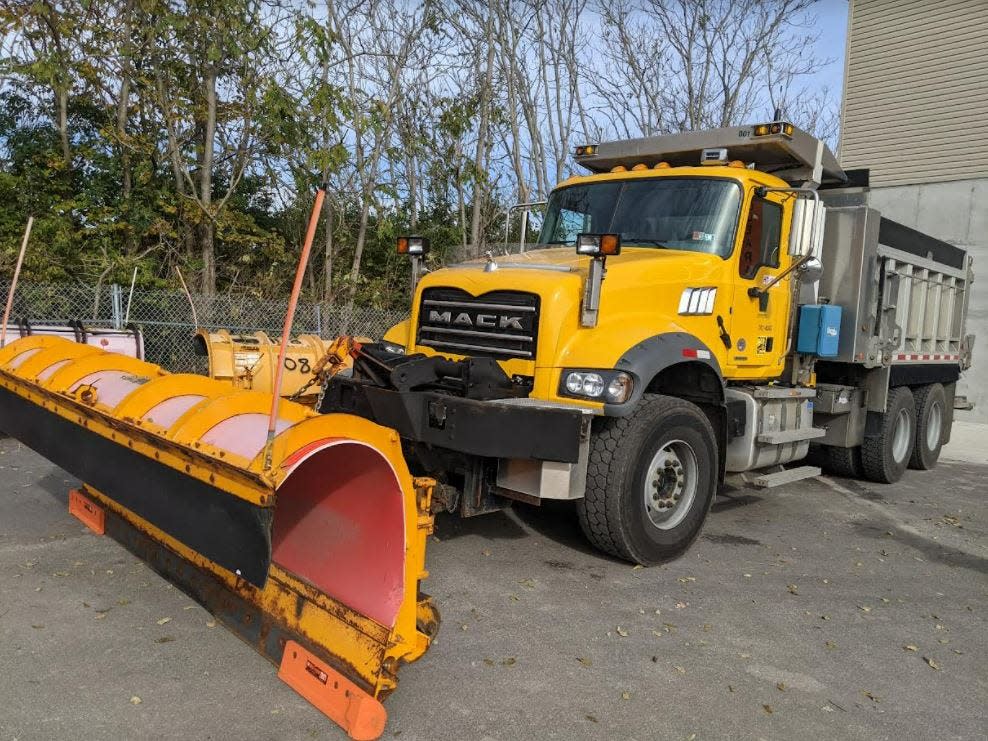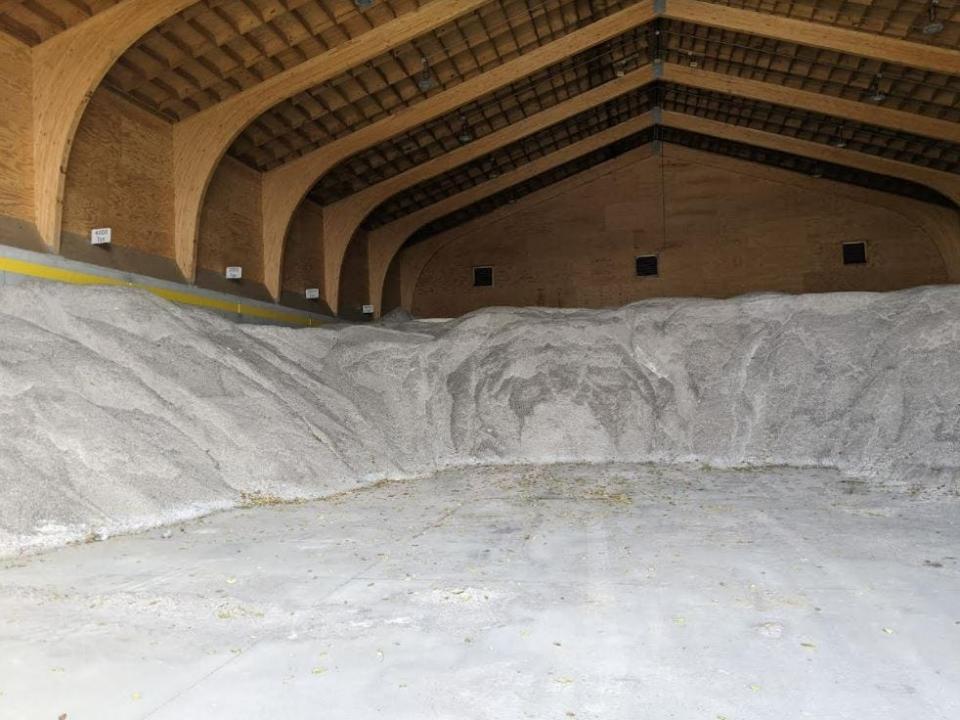State agencies give tips on how to prepare and drive in the winter months

As the month turned to November, many people from Pennsylvania, including PennDOT Executive Deputy Secretary Melissa Batula, know that cold weather and snow and ice on the roads are around the corner.
Batula said at PennDOT the winter season never truly ends, and officials start preparing for the next winter season as soon as the current one ends.
Different officials from PennDOT, the Pennsylvania Emergency Management Agency (PEMA), and the PennDOT Turnpike Commission (PTC) recently gave information on the upcoming winter season, such as tips for driving.
In addition, updates were given on whether there will be enough salt in the county.
More: Predictions call for high precipitation, potentially colder weather for winter season
Driving tips and weather patterns
Batula advises all drivers to give themselves space between snowplows, six car lengths, and said to never try and pass a plow truck while it is working, stating is dangerous for both drivers involved.
She said if there is snow or ice on the road slow down, allow extra space between drivers and don't drive distracted by such things as cell phones.
PTC COO Craig Shuey said all drivers should make sure their vehicles are prepared for the winter, such as checking their wipers, tires and antifreeze levels, and making sure they use windshield washer solutions that are suitable for freezing weather.
He also advised that a gas tank should be at least half-full during a major trip.
Batula said during the last winter season, there were 301 crashes on snow and ice-covered roadways, resulting in 143 injuries and four fatalities.
PEMA Director Randy Padfield said Pennsylvania is known to have significant amounts of precipitation over a short period of time, which in the case of snowstorms, lead to significant snowfall rates that can overwhelm clearance operations, make roads impassable in a short period of time, lead to accidents, close roads and strand motorists.
He said Pennsylvania is known to deal with weather patterns called snow squalls.”
The National Weather Service (NWS) defines a snow squall as a sudden, intense, short-lived burst of heavy snowfall that leads to a quick reduction of visibility, and is often accompanied by gusty winds.
NWS weather notifications
Therefore, Padfield wanted the public to know the different NWS winter weather notifications that PennDOT, PEMA and the PTC use to give guidance to motorists.
A winter weather advisory is issued when there is a threat of winter weather and wintry precipitation that may impact travel, but not an immediate threat to life or safety.
Padfield said under an advisory road safety precautions should be taken, such as slowing down, giving more driving space and giving more time to travel to a destination.
A winter storm watch is given when conditions are favorable for an event that is potentially or is a threat to life and property.
During watches, residents are advised to consider modifying their travel plans. If they must travel, they should pack an emergency kit just in case.
“Watches are usually issued a day or two in advance of any impacts from a winter storm,” Padfield said.
A winter storm warning is given when winter weather is imminent. Warnings are given when half of a foot of snow or more or significant icing situations are expected.
During warnings, drivers are strongly advised to consider modifying, limiting or suspending travel. If they must travel, they are advised to use the above-mentioned advice, as well as have alternate routes in mind in case their regular routes are closed, and be prepared if they become stranded on the roadway.
A snow squall warning is given when a snow squall is in the forecast.
“If you find yourself traveling into a warned area, the only safe location is to exit the roadway and wait until the squall passes,” Padfield said. “It takes a well-informed and prepared public to lessen the impacts from winter weather across the state.”
Added Shuey: “If you can avoid traveling, please do. If you are traveling, maintain sufficient distance between your vehicle and the next to prepare for early and quick stops. At all times, be prepared for stoppages and waiting along the roadway.”
Emergency kits are recommended
Padfield said he recommends drivers have emergency kits in their vehicles in case a winter storm strands them.
The kits should include blankets/sleeping bags, water, food, cell phone chargers, a snow shovel and other items for small children and/or pets.
Padfield also advises residents to keep emergency kits in their homes in case winter weather causes power to go out.
These kits should include shelf staple food, water, battery chargers, a battery-operated radio, flashlights with spare batteries and other supplies for children and pets.
For more information on the kits, go to ready.pa.gov or visit the “Be prepare” link.
PennDOT’s commitment to winter road work
Batula said PennDOT is responsible for over 95,000 snow lane miles in the winter, which is more than all of the roads in the New England states combined.
They will be deploying 4,700 workers and have a $200 million budget for the winter season work. They have stockpiled 560,000 tons of salt, with more coming in deliveries.
During the last winter season, they used over 896,000 tons of salt.
“Winter maintenance is a huge responsibility and we take that very seriously,” Batula said. “This is truly a 24/7 operation.”
PennDOT District 11, which includes all of Lawrence, Beaver, and Allegheny counties, has 6,000 snow lane miles, with 910 snow lane miles in Lawrence.
District 11 Assistant District Executive of Maintenance Lori Musto said there are 126 trucks between the three counties, and currently 229 operators.
Lawrence County has 24 trucks.
Musto said PennDOT has different rental trucks they use in case of emergency, with three in Lawrence.
She said PennDOT relies on different municipal agreements to help clear certain stretches of roads in the counties, with there being seven municipal agreements in Lawrence.
Mutso said the district is still looking for some vacant worker positions, with Lawrence down one permanent worker and three seasonal workers.
She said PennDOT has contingency plans to treat the roads in times of worker shortages and said PennDOT can sometimes hire trainees after they come in and learn the skills needed to pass their CDL license test.
Mutso added 80 percent of the district’s fleet is automatic, and at the district’s main Bridgeville salt shed, it has cameras, which is part of a pilot program to tell personnel how much salt is left and when the supply is running low.
Batula said with all of the roads and routes drivers have to work on during a snowstorm, it is PennDOT’s goal to make sure roads are passable, not completely clear of ice and snow.
“The heavier the traffic, of the heavier the snowfall, the longer it may take our snowplow drivers to complete their route,” Batula said.
Batula said PennDOT said they will work to try and keep at least one interstate road open for commercial traffic during heavy snowfall, but said heavy storms could cause road restrictions and closures.
PTC prepares for winter weather on turnpike
Shuey said they have their own fleet of snow trucks, plows and salt spreaders that they use to clear as much of the turnpike as they can.
He also said their almost 400 equipment operators receive training annually and officials have a plan two to three days in advance of a predicted storm or snowfall, as well as work closely with PennDOT and PEMA.
Local municipalities have no issues regarding salt supply
The Ledger asked the communities of the Ellwood City area if they were able to order the needed supply of road salt, or if the global supply chain issues would affect the salt supply.
Ellwood City Manager David Allen said the borough ordered most of its salt supply during the off-season earlier in the year when it was cheaper. He added there were no delays in delivery, and while the salt cost has increased a little bit, it is not as much as other items.
New Beaver Secretary/Treasurer Drita Crawford said the borough recently ordered two loads of salt and is hoping for no delivery issues.
Perry Township Secretary/Treasurer Janice Marshall said the township orders its salt through the state cooperative purchasing program, or COSTARS, and has not heard anything regarding any form of delay or shortage.

Wampum Secretary/Treasurer Sue Dean said the borough is not expecting any salt shortage this year as well, as they did not have any shortage in 2020.
Wayne Township Secretary/Treasurer Shari Baney said the township is also under contract with COSTARS, and also expects no winter road supply shortages this year as well.
Mutso said Lawrence and Beaver counties are fully stocked with salt, with Lawrence able to hold up to 15,300 tons of salt.
She said there are no delivery issues for the salt, and said PennDOT has the ability to make its own brine to use on the roads as well.
Nicholas Vercilla is a staff reporter for the Beaver County Times and Ellwood City Ledger. He can be reached at nvercilla@gannett.com.
This article originally appeared on Ellwood City Ledger: Lawrence County prepares for the winter 2021-22 season

